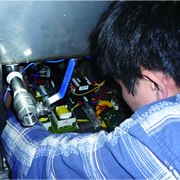|
|
|
|
|
|
Troubleshooting & Repair of Broken Ultrasonic Cleaner |
|
|
18 Jan, 2016 |
Ultrasonic Cleaner |
|
|
|

|
As we know, the ultrasonic cleaner provides us a conveniently cleaning method for a broad range of materials and parts. Generally, troubleshooting or repairing a broken cleaner is not recommended by authorized manufacturer especially during the period of quality guarantee.
Nevertheless, asking help from suppliers has many limitatons such as miscommunication, long maintenance time, higher cost, etc. So that if ultrasonic cleaners are not working well in case of emergency, we can also find several possible causes and troubleshooting by taking some tips to make ultrasonic system run effectively. Now let's briefly look at the guidelines from the following two aspects:
|
|
Troubleshooting & repairing guide for cleaning transducers
1) Damping factor
Generally check the positive and negative terminals of transducers with a megger, we can judge damping condition by an acceptable value of insulation
resistance i.e. the insulation should not be lower than 30 trillion ohms. If the problem is established as dampness, the troubleshooting method is to put
transducers connected with tank as an indivisible whole in to a drying oven and set the temperature at approx. 90 ℃ in a few hours. As an alternative, a
blow dryer can be also used for drying work until the resistance value return to a normal level.
2) Piezoelectric crystals broke down
We can determine whether the piezo crystals inside cleaning transducers have indeed damaged by visual inspection or measuring by megameter. Because it's
hard for a non-experter to replace a new transducers, just disconnect the broken transducers as a simple treatment.
3) Debonding from the bottom of cleaning tank
Nowadays ultrasonic transducers are commonly bonded to the cleaning tank through adhesive technology. Besides, most of manufacturers have bolts welded to
the bottom of plate. Due to be fastened with screws, transducers won't drop down from the tank even if any of transducers are de-bonded. The general method
is that we can gentlely wiggle them to determine if they become loose.
In most cases, the de-bonded transducers still delivery the poor power into cleaning solution, result in much energy can't be released from oscillators. So
that it causes a high risk of damage by overheat. In daily use, it is very important to avoid whack, bump, impact and other ways to make mechanical stress
on vibration surface.
4) Damage on vibration surface
This kind of situation will only happen on condition that the ultrasonic cleaners serve for a long time. Stainless steel tank can be damaged from cavitation
corrosion caused by long-term and high-frequency oscillation. If so, you need to ask your suppliers for replaceable parts and repair services.
Troubleshooting & repairing guide for ultrasonic generators
1) Indicator does not light
Remove loads(i.e. any oscillators) from generator and restart. If indicator light is bright, that means the loads are not work. Conversely, If the issue
still occurs after the loads are removed, go to the next step below.
Check to make sure the power supply is plugged in correctly and close the leakage switch, troubleshoot whether the power switch is broken. Past experience
has taught us that there is a great possibility of the connection issues between plug and socket.
2) Indicator does not light after running some time
Troubleshoot whether the flus is blown, rectifier bridge or power tube is burned out. Carefully examine the circuit board and related components to find out
the reason of overload e.g. shorting circuting. It is noteworthy that the aging transducer may also cause unstable current, and further to broke the
generator.
3) Lower output when indicator lights up
Apart from the own problem of loads, it's probably caused by frequency mismatching between oscillators and generator, we can solve it by following
troubleshooting steps:
Turn off the power, change the matching inductance via adding or reducing inductance's gasket. Then turn on the generator, use screwdrive to regulate
frequency potentiometer slowly(0.5khz each time) to find the optimal working frequency, at this point, the current reaches its maximum value.
4) No output when indicator lights up
There are many possibilities in this case, first examine and check whether the connection between generator and transducers is in good condition. Use
multimeter to confirm if there are any breaks in power line and plug. If all is good, maybe a breakdown happens inside the power generator. Finally ensure
that transducers are intact with no short circuit.
|
|
« Back |
|
↑ Top |
|
|
|
|
 Downloads
Downloads Sitemap
Sitemap Downloads
Downloads Sitemap
Sitemap